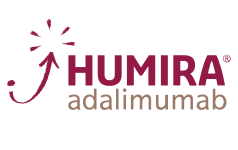For adult patients with moderate to severe chronic plaque psoriasis (Ps)
Achievement of skin clearance in Ps1
REVEAL
Adult patients with moderate to severe chronic plaque psoriasis and ≥10% BSA involvement, PASI score ≥12, and PGA of at least moderate disease severity.1,2
CHAMPION
Adult patients with moderate to severe plaque psoriasis (defined as ≥10% BSA and PASI ≥10).1,3
REVEAL study design intro: REVEAL was a 52-week, randomized, double-blind, placebo-controlled trial in adult patients with moderate to severe chronic plaque psoriasis.1,2
CHAMPION study design intro: CHAMPION was a 16-week, randomized, double-blind, placebo-controlled study of adult patients with moderate to severe plaque psoriasis.1,3
Skin clearance: 16 weeks
PGA: Clear or minimal (co-primary endpoint)1,3-5,a
REVEAL1,2,4
62%
VS
4%
CHAMPION3
73%
VS
11%
HUMIRA 80 mg at Week 0, 40 mg EOW starting at Week 1
(REVEAL n=814; CHAMPION n=108)
Placebo (REVEAL n=398; CHAMPION n=53)
- HUMIRA 80 mg at Week 0, 40 mg EOW starting at Week 1 (REVEAL n=814; CHAMPION n=108)
- Placebo (REVEAL n=398; CHAMPION n=53)
REVEAL: P<0.001
CHAMPION: P<0.001
aPGA of Clear defined as no plaque elevation, no scale, plus or minus hyperpigmentation or diffuse pink or red coloration. Minimal defined as possible, but difficult to ascertain whether there is slight elevation of plaque above normal skin, plus or minus surface dryness with some white coloration, plus or minus up to red coloration.1 PGA of Severe defined as marked plaque elevation typically with hard or sharp edges; coarse, nontenacious scale predominates covering most or all of the lesions; very bright red coloration.
From the full Prescribing Information for HUMIRA1
The data assessed in the HUMIRA full Prescribing Information included only patients in CHAMPION with a baseline PASI ≥12 and therefore differ from the data shown here.
- 71% of HUMIRA-treated patients (n=99) achieved a PGA score of clear or minimal at Week 16 vs 10% of placebo-treated patients (n=48)1
BSA=body surface area; EOW=every other week; OLE=open-label extension; PGA=physician’s global assessment
PASI 75 Improvement1-3,a
REVEAL1,2
71%
VS
7%
CHAMPION3
80%
VS
19%
HUMIRA 80 mg at Week 0, 40 mg EOW starting at Week 1
(REVEAL n=814; CHAMPION n=108)
Placebo (REVEAL n=398; CHAMPION n=53)
- HUMIRA 80 mg at Week 0, 40 mg EOW starting at Week 1 (REVEAL n=814; CHAMPION n=108)
- Placebo (REVEAL n=398; CHAMPION n=53)
REVEAL: P<0.001
CHAMPION: P<0.001
aPASI 75 represents ≥75% improvement in skin clearance from baseline.3
From the full Prescribing Information for HUMIRA1
The data assessed in the HUMIRA full Prescribing Information included only patients in CHAMPION with a baseline PASI >12 and therefore differ from the data shown here.
- 78% of HUMIRA-treated patients (n=99) achieved PASI 75 improvement at Week 16 vs 19% of placebo-treated patients (n=48).1
BSA=body surface area; EOW=every other week; OLE=open-label extension; PASI=Psoriasis Area and Severity Index
Response rates: PGA* and PASI75† at 3 years5-7
- Observed analysis of PGA 0/1, PASI 75 response in patients who received continuous HUMIRA through Week 52 and entered the OLE study.
- Observed analysis of PGA 0/1, PASI 75 response after 160 weeks of HUMIRA 40 mg every EOW.
The analysis to treat was based on the intention-to-treat population, with missing values imputed as nonresponders5
- OLE limitations: As with any long-term open-label extension (OLE), there are several limitations with the OLE portion of this study. For example, there is the potential for enrichment of the long-term data in the remaining patient population, as those who remain in the study generally fare better than those who discontinue.5
- The use of HUMIRA in moderate to severe chronic plaque psoriasis beyond one year has not been evaluated in controlled clinical trials.1
- OLE populations generally consist of treatment responders. Patients who are unable to tolerate or who do not respond to the drug often drop out.
- Patient responses were analyzed relative to baseline of REVEAL.
*PGA of clear defined as no plaque elevation, no scale, plus or minus hyperpigmentation or diffuse pink or red coloration. Minimal defined as possible but difficult to ascertain whether there is slight elevation of plaque above normal skin, plus or minus surface dryness with some white coloration, plus or minus up to red coloration.1
†PASI 75 represents a ≥75% improvement in skin clearance from baseline.
BSA=body surface area; EOW=every other week; OLE=open-label extension; PASI=Psoriasis Area and Severity Index; PGA=physician’s global assessment
Fingernail Psoriasis Study: Improvement in moderate to severe fingernail psoriasis at 26 weeks1,8
PGA-F: Moderate to minimal response1,8,a
49%
VS
7%
PROPORTION OF PATIENTS THAT ACHIEVED A PGA-F OF CLEAR OR MINIMAL PRIMARY ENDPOINT
Achieving PGA-F Clear or Minimal requires a PGA-F score of 0 or 1 with ≥2-grade improvement from baseline.
- HUMIRA 80 mg at Week 0, 40 mg EOW (n=109)a
- Placebo EOW (n=108)
aSubjects received 80 mg of HUMIRA at Week 0, followed by 40 mg every other week starting at Week 1.
P<0.001
PGA-F1,8
- PGA-F is a 5-point scale used to assess a subject’s fingernails separately for nail bed and nail matrix signs of disease
- A global score between 0 (clear) and 4 (severe) is assigned for both nail bed and nail matrix scores. For example, a patient with a nail bed score of 2 and nail matrix score of 4 has an overall score of 4
- The overall global score is the worse of the nail bed and nail matrix scores
Primary Endpoint1,8
Proportion of patients who achieved PGA-F of 0 or 1, plus at least 2-grade improvement from baseline at Week 26
STUDY DESIGN INTRO
A 26-week, Phase 3, randomized, double-blind, placebo-controlled study of the safety and efficacy of HUMIRA in adult patients with moderate to severe chronic plaque psoriasis with moderate to severe fingernail psoriasis.2
PGA-F=Physician's Global Assessment of Fingernail Psoriasis.
Safety data: 16 Weeks9
Adverse events (AE) of interest rates at Week 16 (Events/100 PYs)
| HUMIRA (n=814) PYs=250.2 |
PLACEBO (n=398) PYs=120.7 |
|
| Serious AE | 6.8 | 5.8 |
| Any AE leading to trial discontinuation | 2.0 | 0.0 |
| Serious infection | 2.8 | 3.3 |
| Malignancya | 0.8 | 0.8 |
| Lymphoma | 0.0 | 0.0 |
| Active tuberculosis | 0.0 | 0.0 |
aIn REVEAL, malignancies excluded lymphoma and non-melanoma skin cancer.
PYs=patient-years
Adverse reaction rates observed in clinical trials may not predict the rates observed in a broader patient population in clinical practice.
RISK OF SERIOUS INFECTION1
Patients treated with HUMIRA are at increased risk for developing serious infections that may lead to hospitalization or death. Most patients who developed these infections were taking concomitant immunosuppressants such as methotrexate or corticosteroids.
Carefully consider the risks and benefits of treatment with HUMIRA prior to initiating therapy in patients with chronic or recurrent infection. Monitor patients closely for the development of signs and symptoms of infection during and after treatment with HUMIRA.
- Do not start HUMIRA in patients with an active infection, including localized infections
- Patients older than 65 years, patients with co-morbid conditions, and/or patients taking concomitant immunosuppressants may be at greater risk of infection
RISK OF MALIGNANCY1
Lymphoma, including a rare type of T-cell lymphoma, and other malignancies, some fatal, have been reported in patients treated with TNF blockers, including HUMIRA.
- Consider the risks and benefits of HUMIRA treatment prior to initiating or continuing therapy in patients with a known malignancy
- More cases of malignancies were observed among HUMIRA-treated patients compared to control patients in clinical trials
RISK OF TUBERCULOSIS1
Patients treated with HUMIRA are at increased risk for developing serious infections that may lead to hospitalization or death, including active tuberculosis (TB), including reactivation of latent TB. Patients with TB have frequently presented with disseminated or extrapulmonary disease.
- Test patients for latent TB before HUMIRA use and during therapy. Initiate treatment for latent TB prior to HUMIRA use
- Monitor patients closely for the development of signs and symptoms of infection during and after treatment with HUMIRA, including the development of TB in patients who tested negative for latent TB infection prior to initiating therapy
RISK OF LYMPHOMA1
Lymphoma and other malignancies, some fatal, have been reported in children and adolescent patients treated with TNF blockers, of which HUMIRA is a member.
Postmarketing cases of hepatosplenic T-cell lymphoma (HSTCL), a rare type of T-cell lymphoma, have occurred in adolescent and young adults with inflammatory bowel disease treated with TNF blockers including HUMIRA.
- The rate of lymphoma in controlled and uncontrolled clinical trials of HUMIRA in patients with rheumatoid arthritis, psoriatic arthritis, ankylosing spondylitis, Crohn's disease, ulcerative colitis, plaque psoriasis, hidradenitis suppurativa, and NI uveitis* was approximately 3-fold higher than expected in the general population.
*Non-infectious (NI) intermediate, posterior, or panuveitis





